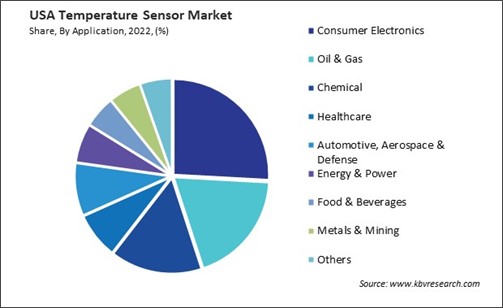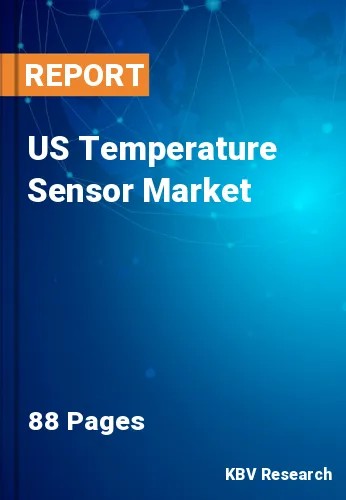The USA Temperature Sensor Market size is expected to reach $2.2 billion by 2030, rising at a market growth of 4.7% CAGR during the forecast period. In the year 2022, the market attained a volume of 21,666.0 thousand units, experiencing a growth of 4.3% (2019-2022).
The temperature sensor market in the U.S. has been witnessing significant growth driven by advancements in technology, increasing industrial automation, and the growing demand for temperature monitoring in various sectors. Temperature sensors play a crucial role in ensuring product quality, process efficiency, and compliance with regulatory standards across industries such as manufacturing, healthcare, automotive, and consumer electronics.

One of the key drivers of the temperature sensor market is the rising adoption of IoT (Internet of Things) devices and smart technologies. Accurate and reliable temperature sensing becomes essential as more industries integrate IoT solutions into their operations. Temperature sensors are integral to IoT-enabled devices, facilitating real-time monitoring and data analysis for better decision-making.
Environmental monitoring, particularly in the context of temperature sensors, has become a critical aspect of various industries in the United States. The integration of temperature sensors into environmental monitoring systems has grown significantly, driven by the need for sustainable practices, regulatory compliance, and a growing awareness of environmental impacts.
Agriculture, an industry deeply influenced by environmental conditions, has also embraced temperature sensors for monitoring crops, storage facilities, and transportation in the United States. These sensors contribute to precision agriculture practices, helping farmers optimize growing conditions and reduce waste. Monitoring temperature variations is crucial for preserving agricultural products' quality and shelf life from farm to industry.
In the United States, the temperature sensor market has experienced a notable surge in demand, primarily driven by an increased focus on the healthcare sector. The healthcare industry has become acutely aware of the critical role that temperature monitoring plays in various applications, such as pharmaceutical storage, vaccine transportation, and medical device management. With the global challenges posed by the COVID-19 pandemic, ensuring the integrity of temperature-sensitive medical supplies has become paramount. As a result, healthcare facilities are increasingly investing in advanced temperature sensor technologies to maintain the required conditions for storage and transportation of medications, vaccines, and biological samples.
This heightened focus on temperature sensing in healthcare is driven by regulatory compliance and the industry's commitment to enhancing patient safety and the efficacy of medical treatments. Using precise and reliable temperature sensors ensures that medications retain their potency, vaccines remain effective, and medical equipment operates optimally.
According to CMS.gov, U.S. healthcare spending experienced a 4.1 percent growth in 2022, reaching a staggering $4.5 trillion, equivalent to $13,493 per person. This expenditure constituted 17.3 percent of the nation's Gross Domestic Product. Shifting gears to the temperature sensor market in the U.S. reflects a parallel trajectory of expansion and prominence, mirroring the upward trend observed in healthcare spending. As the healthcare sector continues to prioritize patient well-being and regulatory standards, the temperature sensor market in the United States is expected to witness sustained growth, with innovations in sensor technologies addressing the evolving needs of the healthcare industry.
The temperature sensor market in the U.S. is experiencing a notable shift towards an increased focus on energy efficiency. With growing awareness of environmental sustainability and the need to reduce energy consumption, businesses and industries actively seek temperature-sensing solutions that contribute to overall energy efficiency. This trend is particularly evident in the manufacturing, healthcare, and building automation sectors. Moreover, government incentives and regulations are encouraging businesses to adopt energy-efficient technologies. Tax credits and grants for implementing green technologies create a favorable environment for companies investing in advanced temperature-sensing solutions.
Temperature sensor manufacturers are developing innovative and energy-efficient solutions in response to this demand. These sensors provide accurate temperature measurements while minimizing power consumption and optimizing overall system efficiency. Integrating advanced technologies, such as low-power sensors and wireless communication capabilities, enables real-time monitoring and control, contributing to better energy management strategies. Government initiatives and regulations promoting energy efficiency further drive the adoption of such sensors across various applications. Hence, as the U.S. continues to prioritize sustainable practices, the energy-efficient temperature sensor market is poised for significant growth, offering both environmental benefits and economic advantages for businesses embracing these technologies.

The temperature sensor market in the United States is a dynamic and rapidly growing sector driven by technological advancements, increasing demand for automation, and the need for precise temperature monitoring across various industries. Several key players contribute to the growth and innovation within this industry, each offering unique solutions to cater to diverse applications.
One of the leading companies in the U.S. temperature sensor market is Texas Instruments. Known for its semiconductor and integrated circuit solutions, Texas Instruments provides a wide range of temperature sensor products that find applications in automotive, industrial, and consumer electronics. Their sensors are renowned for accuracy, reliability, and versatility, making them a preferred choice for many industries.
Analog Devices Inc. (ADI) is another prominent player in the temperature sensor market. ADI specializes in high-performance analog, mixed-signal, and digital signal processing (DSP) integrated circuits. Their temperature sensor offerings are used in industrial automation, healthcare, and automotive applications. Similarly, Maxim Integrated, now a part of Analog Devices, is recognized for its expertise in analog and mixed-signal integrated circuits. The company offers a diverse portfolio of temperature sensor products suitable for medical devices, wearables, and industrial equipment applications. Maxim Integrated's focus on energy efficiency and miniaturization has made its temperature sensors popular in space-constrained applications.
STMicroelectronics, a global semiconductor leader, has a significant presence in the U.S. temperature sensor market. The company's sensors cater to various applications, including automotive, industrial, and consumer electronics. STMicroelectronics is known for its innovative sensor solutions that enable enhanced performance and efficiency in various end products.
Honeywell International, a diversified technology and manufacturing company, holds a prominent position in the temperature sensor market, particularly in aerospace, healthcare, and industrial applications. The company's emphasis on developing smart and connected sensor solutions aligns with the rising trend of IoT integration in temperature monitoring systems. Similarly, T.E. Connectivity, a major provider of connectivity and sensor solutions, plays a crucial role in the U.S. temperature sensor market, catering to industries like automotive, aerospace, and industrial automation. With a diverse product portfolio and a commitment to innovation, T.E. Connectivity stands out in the temperature sensing domain.
By Type
By Application
Our team of dedicated experts can provide you with attractive expansion opportunities for your business.

